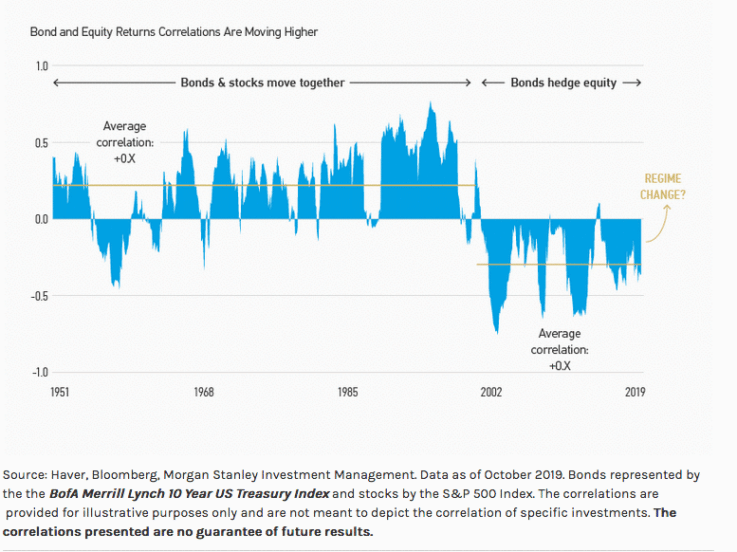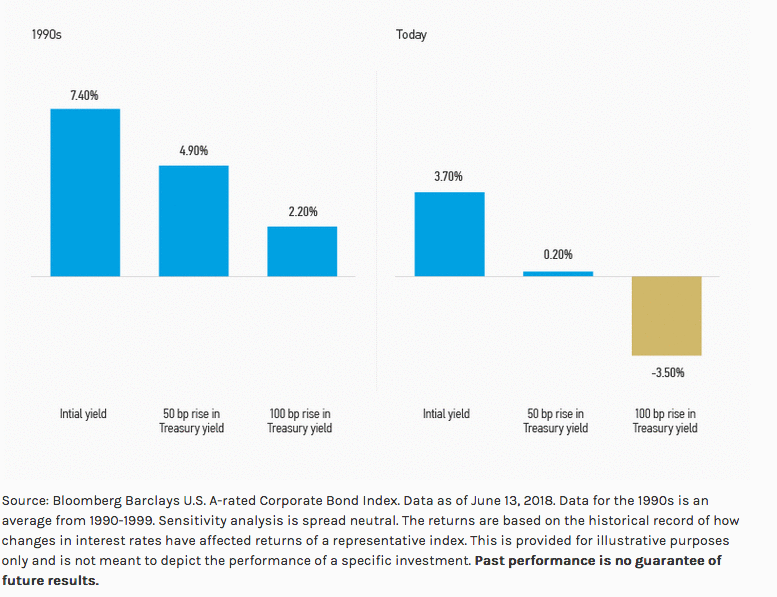
Morgan Stanley: The Real Problem with Low Yields
High grade fixed income plays a special role in managing risk because it tends to be a safer, more liquid and less volatile asset.
02.12.2019 | 13:30 Uhr
It acts as the rope a rock climber may clutch onto during precarious times. We still think that is largely true, however, there is a catch. It is that bonds currently are trading at very low yields, even negative yields in many cases. In these conditions, investors who are tied to traditional bond strategies may find they are less effective in acting as a hedge and also have less appreciation potential than when yields were higher. As an alternative, we suggest active fixed income strategies that can offer better diversification benefits throughout changing environments for those willing to assume a greater degree of risk.
Problem: Low yields have eroded diversification benefits
Today’s terrain, however, entails a unique set of risks. Those
seeking shelter in bonds should know that, in addition to diminished
income streams, the low yield environment has also increased the
correlation of returns between fixed income and equities. Increasingly,
stocks and bond are moving together (Display 1), meaning
investors in a traditionally balanced portfolio, consisting of 60%
equities and 40% bonds, may not be getting adequate diversification.
Display 1: Is your portfolio as diversified as you think?

We think the low yield environment is the primary contributor to this rise in correlation. Over the past six months, the 10-year German Bund has ranged between -0.70% to -0.20% and US 10-year Treasury from 1.50% to 2.00%. At these levels, there is little room to generate gains from further rate declines. (Display 2). With such little potential for gains, investors cannot look to bonds to potentially offset disappointing equity returns – should that scenario unfold. Similarly, bond yields are not sufficiently high enough to maintain positive performance even for a modest move higher in interest rates.
Display 2: Little room for maneuvering

It thus becomes mathematically more difficult to achieve the benefits offered by diversification when correlations rise. For a portfolio comprised of equity and fixed income, this reduction in diversification benefits may increase the volatility of returns.
Solution: Look beyond the interest rate cycle for bond returns
Since the source of the rise in correlation is the low level of interest rates, then the solution must involve ways reduce the dependency of bond returns from the interest rate cycle.
Active management that looks for opportunities across assets and geographies can help. These flexible strategies have the latitude to generate alpha through in-depth analysis on duration, sectors, credit spreads and yield curve structure. By selectively choosing sectors that have been de-coupled from the interest rate cycle, active managers can seek to preserve the diversification benefits offered by fixed income and potentially improve returns. For example, we can select from global assets whose returns may improve as the economic cycle strengthens, such as credit and some Emerging Market bonds, during periods when interest rates may rise. Similarly, during a declining interest rate cycle we can select higher quality longer duration assets to help capture performance. Keep in mind, investing in these opportunities involve greater risks. Nonetheless, it is this flexibility across a wide investment opportunity set that provides an opportunity for active managers to achieve returns whether interest rates are rising or falling.
The fear of falling is real
Investors concerned about current market conditions and the
diminished correlation between stocks and bonds should consider actively
managed strategies. An active manager has the latitude to use a variety
of tactics to de-couple from the interest rate cycle in an effort to
maintain balance and diversification. The fear of falling is real, but
knowing that there is someone at the helm continually looking for
opportunities and seeking to guard against risks can provide an anchor
in uncertain times.
Risk Considerations
Diversification does not eliminate the risk of loss.
Fixed-income securities are subject to the ability of an issuer to make timely principal and interest payments (credit risk), changes in interest rates (interest rate risk), the creditworthiness of the issuer and general market liquidity (market risk). In a rising interest-rate environment, bond prices may fall and may result in periods of volatility and increased portfolio redemptions. In a declining interest-rate environment, the portfolio may generate less income. Longer-term securities may be more sensitive to interest rate changes. Certain U.S. government securities purchased by the strategy, such as those issued by Fannie Mae and Freddie Mac, are not backed by the full faith and credit of the U.S. It is possible that these issuers will not have the funds to meet their payment obligations in the future. Public bank loans are subject to liquidity risk and the credit risks of lower-rated securities. High-yield securities (junk bonds) are lower-rated securities that may have a higher degree of credit and liquidity risk. Sovereign debt securities are subject to default risk. Mortgage- and asset-backed securities are sensitive to early prepayment risk and a higher risk of default, and may be hard to value and difficult to sell (liquidity risk). They are also subject to credit, market and interest rate risks. The currency market is highly volatile. Prices in these markets are influenced by, among other things, changing supply and demand for a particular currency; trade; fiscal, money and domestic or foreign exchange control programs and policies; and changes in domestic and foreign interest rates. Investments in foreign markets entail special risks such as currency, political, economic and market risks. The risks of investing in emerging market countries are greater than the risks generally associated with foreign investments. Derivative instruments may disproportionately increase losses and have a significant impact on performance. They also may be subject to counterparty, liquidity, valuation, correlation and market risks. Restricted and illiquid securities may be more difficult to sell and value than publicly traded securities (liquidity risk).




Diesen Beitrag teilen: